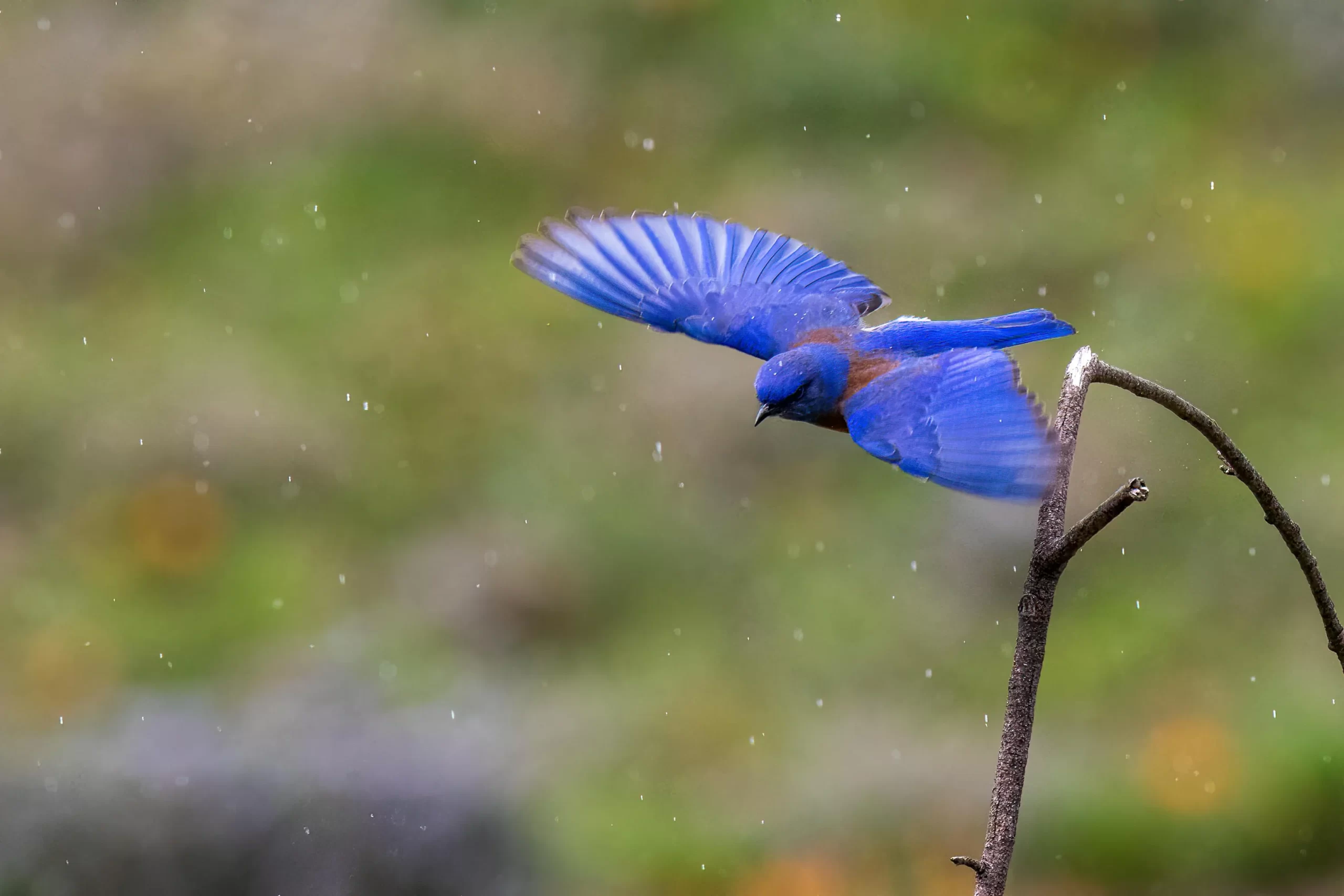California is a birder’s paradise, with more than 700 bird species being observed in the state. Indeed, more birds have been observed here than in most countries. While all of this bird diversity is exciting, it can make it difficult to identify some species. For instance, there are about 25 common blue birds in California, and separating these dazzling creatures can be challenging. So, what blue birds are in California?
Don’t worry – I’ve created this thorough guide to the different types of blue birds in California! Here, I’ll discuss California blue birds—both big and small—as I thoroughly cover all of the types of blue birds in CA. Let’s get started!
Table of Contents
22 Types of Blue Birds In California
Blue-winged Teal

Blue-winged Teal are common waterfowl in California, with more than 70,000 reports of these birds submitted to eBird from the state. These migratory birds in California are most common in the winter, but most leave the state in the summer to breed elsewhere.
Both male and female Blue-winged Teals are blue California birds, but the blue coloration on males is much more obvious. For instance, males have blue heads, while females have brown heads and bodies. You may thus be wondering why I consider female Blue-winged Teals to be blue birds in California. Well, it is because of their namesake blue wings! Indeed, both males and females have blue wing patches that are visible in flight.
Look for Blue-winged Teals in aquatic habitats such as marshes, ponds, and lagoons. They are social birds, so they will typically be in the presence of other California waterfowl.
Harlequin Duck

Harlequin Ducks make a strong case for the most beautiful blue bird in California, as the males sport breathtaking plumage in the breeding season. Yes, males have dark blue necks and backs, while their chests are a slightly lighter shade of blue. They’ve also got a white crescent on either side of their face, while their eyebrows and sides are rusty-colored.
Although male Harlequin Ducks are undoubtedly dark blue birds in California, females are not blue at all. Instead, they are brownish-gray overall with white patches on their faces. This California blue bird is considered regular but uncommon in the state.
Harlequin Ducks are sea birds in California, so they’re primarily found along the coast where they frequently dive into the ocean to pursue fish or mollusks. Harlequin Ducks are rare in inland California, but they may be found among fast-flowing water within streams or rivers when they do venture inland.
Little Blue Heron

Little Blue Herons have an interesting distribution in California. Here, they are considered to be rare in most of the state, but a small population around San Diego seems to be well-established and regular. Elsewhere, seeing a Little Blue Heron is an unexpected treat, and they are progressively more notable as one gets further north in the state.
These blue birds of Southern California are all blue birds that forage along mudflats, estuaries, and lakeshores. Although adults are entirely blue, immature birds are entirely white. Therefore, young birds are often confused with egrets.
Finding Little Blue Herons in California is a matter of chance anywhere but San Diego, with no time of year being distinctly more likely to yield one of these birds. They may be found year-round around San Diego.
Great Blue Heron
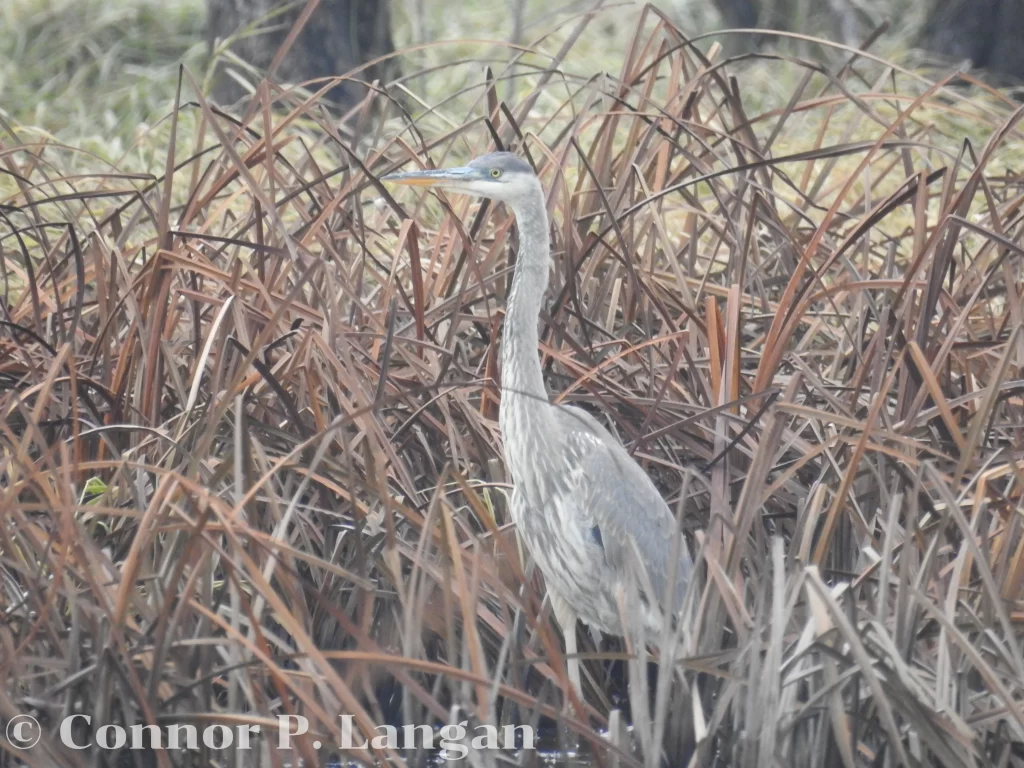
Of course, a list of the different blue birds in California would not be complete without the inclusion of the Great Blue Heron. Now, these big blue birds are not truly blue at all. Rather, their bodies are more light gray in coloration. Nonetheless, these creatures deserve a spot on this list anyway.
Great Blue Herons are abundant in California, being found throughout the state in a wide array of aquatic habitats. Ponds, lakes, lagoons, streams, and most freshwater ecosystems can support Great Blue Herons.
These blue birds with long beaks use their bills to impale unknowing fish, amphibians, and small mammals within the habitats where they forage. Great Blue Herons often nest in sizable rookeries where they may live communally with other herons.
Belted Kingfisher

Belted Kingfishers are the only kingfisher that calls California home. These blue-colored birds in California have shaggy crests and large, broad heads. Unlike most birds, it is the female Belted Kingfishers who are more colorful than the males. Both sexes are light blue birds thanks to their blue heads, backs, and belts that extend across their breasts. However, females also have orangish flanks to pair with their white undersides.
Belted Kingfishers survive in aquatic ecosystems where they not only eat fish but also amphibians and occasionally insects. They are easy to overlook in their habitats, but their abrupt, rattle-like calls often betray their presence.
These expert anglers are generally nonmigratory in California, but some birds may descend to lower elevations in the winter after breeding in the mountains during summer. Therefore, birders can enjoy seeing Belted Kingfishers year-round in California.
Pinyon Jay

Few kinds of birds in California are as blue as a Pinyon Jay. Indeed, these odd-looking jays are rightfully lumped with other blue California birds, as they are bright blue birds overall. Males and females are sexually monomorphic, meaning both are all blue birds.
Pinyon Jays are very social, and they are rarely found away from others of their species. They frequent pine trees in semi-open areas, and they are often found at considerable elevations.
These blue birds in California are very nomadic, as groups are routinely moving around as they search for a good place to enjoy their next meal. They may be found during any time of year in California, but—unfortunately—their populations have been declining rapidly in the past few decades.
Steller’s Jay

Steller’s Jays are large, dark blue birds with a distinct crest and mischievous behavior. Males and females look alike, with each of these wild birds in California being quite blue. Although their crests and chests are black, their stomachs and undersides are dark blue.
Steller’s Jays are regular backyard birds in California. Here, they may eat suet or devour peanuts, sunflower seeds, or other treats. These California blue birds have bold personalities, and some birders soon grow sick of their presence since they often chase away other birds.
These large jays are found in coniferous forests where they often forage in loose feeding groups. Steller’s Jays are nonmigratory, being common blue birds in Northern California. However, they are found throughout the state save for the southeast corner.
Island Scrub-Jay

The Island Scrub-Jay is a special California blue bird that is endemic to the Channel Islands. Therefore, these Southern California birds are a highly sought specialty that birders from around the world hope to see.
Those who are lucky enough to observe these rare blue birds in California will certainly not overlook the blue heads, backs, and tails of these corvids. They look rather similar to California Scrub-Jays, but their bills are more heavyset and their plumage has a few different colors and patterns.
Island Scrub-Jays are nonmigratory, remaining within the Channel Islands where they hang out in groups in habitat with young trees and shrubs. They are certainly the prized jewel of blue birds in California.
California Scrub-Jay

Image attribution: “California Scrub-Jay” by Becky Matsubara is licensed under CC BY 2.0
California Scrub-Jays are absolutely abundant in their namesake state, with nearly 1.5 million eBird checklists reporting this species in the state. These clever jays are among the most resourceful of the types of blue birds in California, as they are known to stash large collections of food.
The blue tails, necks, wings, and heads of California Scrub-Jays have rightfully solidified their status as a California blue bird. They are nonmigratory and very versatile, and they can therefore be found in a wide variety of habitats.
Look for California Scrub Jays in parks, backyards, open oak woodlands, and mixed forests. Their calls have a somewhat metallic tone to them, and these squawks often give away their presence. These blue birds of California can be found throughout most of the state, but they are absent from the far southeastern corner.
Woodhouse’s Scrub-Jay

Woodhouse Scrub-Jays were lumped in the same species as California Scrub-Jay until recently, and it’s easy to see why ornithologists considered them to be conspecific. Both of these California blue birds have blue distributed throughout the same parts of their bodies, but Woodhouse’s Scrub-Jays tend to be slightly paler than their California counterparts.
Moreover, Woodhouse’s Scrub-Jays are found in slightly different habitats than California Scrub-Jays, as they prefer open oak and pine habitats that feature many young trees. The calls of the two species are also different.
Whereas California Scrub-Jays are found throughout most of the state, Woodhouse’s Scrub-Jays are confined to the far eastern portions of California, so birders will have to travel east to check this California blue bird off their state list.
Tree Swallow

Male Tree Swallows are bright blue birds that have an iridescence to their plumage that makes them sparkle when the light catches them. Females may be somewhat blue, but they are usually more of a brown color.
These aerial insectivores are common around lakes, ponds, and marshes in California. Here, these blue birds in California nest in tree cavities or readily use birdhouses. Hosting a pair of Tree Swallows will offer a landowner many benefits, but these protective parents may dive-bomb anyone who approaches too closely.
Tree Swallows may be found year-round in California, but they tend to be more common in southern California during the winter. They may breed anywhere adjacent to water that contains cavities in which they can nest.
Barn Swallow

Barn Swallows are among the most familiar swallows in California, with their blue backs and forked tails being familiar sights to many. Males and females are sexually monomorphic, with both being dark blue birds with orange undersides.
Barn Swallows have evolved to be quite adaptable, and they construct their mud nests on a variety of structures such as shelters, houses, sheds, and barns. Although their mud nests may make some dislike them, their diets make them a helpful ally.
Barn Swallows breed throughout all of California save for the southeastern corner of the state. They are uncommon northern California blue birds in winter, but they get progressively more common as one travels further south.
White-breasted Nuthatch

White-breasted Nuthatches are familiar backyard birds in California where their pleasant mannerism has endeared them to many. Both males and females are light blue birds with white undersides.
White-breasted Nuthatches can be found in a variety of habitats in California. Parks, mixed woodlands, and woodlots are often good places to look, but they do not do as well in coniferous forests as some of their nuthatch counterparts.
These common blue birds in California will readily visit backyard bird feeding stations where they gobble up a variety of seeds. White-breasted Nuthatches are nonmigratory, so birders can enjoy these blue birds of California in their yards for the entire year.
Pygmy Nuthatch
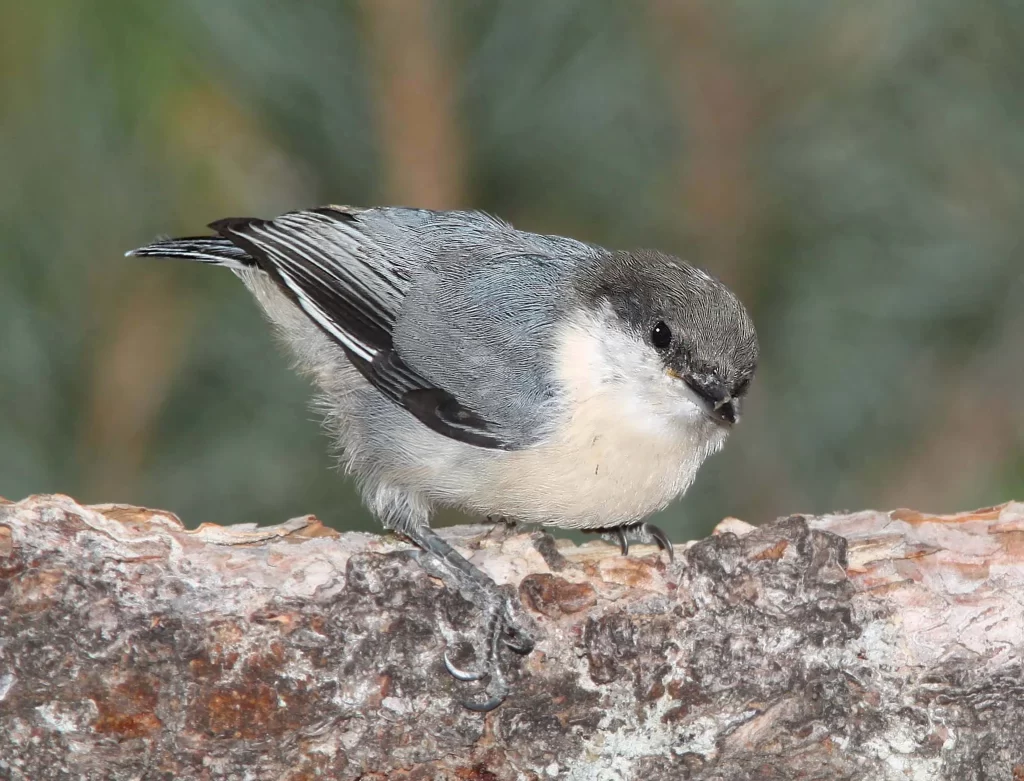
Pygmy Nuthatches are tiny blue birds with brown caps, pale undersides, and blue backs. They can be difficult to spot as they forage high in trees, but their high-pitched calls may reveal their presence.
Pygmy Nuthatches have an interesting distribution in California, as three populations exist that do not connect. One population stretches from Lucia in the south to Fort Bragg in the north. Another from Santa Barbara jogs east before stretching north along the eastern border of California. The last population is present in the Angles National Forest south to the Cleveland National Forest.
As you may have inferred, Pygmy Nuthatches thrive in coniferous forests. Therefore, such habitats are optimal, although they may be found in parks or at backyard bird feeders.
Red-breasted Nuthatch

Red-breasted Nuthatches are—of course—associated with the color red thanks to their red undersides, but these small songbirds also have blue backs that are worth mentioning. Indeed, these creatures certainly deserve to be mentioned on this list of blue birds in California.
Red-breasted Nuthatches are strongly tied to California’s pine forests. Here, this California blue bird thrives up to considerable elevations. They are abundant in the Sierra Nevada Mountains, but they are absent from California’s Central Valley.
Unlike the other nuthatches on this list, Red-breasted Nuthatches are nomadic. Therefore, they will make seasonal movements during fall and winter as they move around in search of food.
Blue-gray Gnatcatcher

Blue-gray Gnatcatchers are aptly named, as these light blue birds feature plenty of blue on their backs. They are active songbirds, and they can frequently be observed hopping around from branch to branch in their pursuit of insects.
These petite creatures breed in brushy habitats, so anywhere with young trees or shrubs may be alluring. They are often found near water, but this is not a prerequisite for breeding.
Therefore, look for Blue-gray Gnatcatchers in parks, riparian habitats, and scrublands. These blue birds in California can be found in all parts of the state at some points of the year.
Black-tailed Gnatcatcher

Male Black-tailed Gnatcatchers have a cool blue back. They look similar to Blue-gray Gnatcatchers, but they have a distinct black cap. Females are largely gray overall and are thus not considered to be blue birds in California.
Black-tailed Gnatcatchers are found in arid habitats where they fly around in shrubs and young trees. Canyons, hillsides, and open areas with decent amounts of vegetation will be appealing to these animals.
These blue birds with long beaks are southeastern California specialties. Here, they are rarely observed north of Death Valley National Park, and these blue birds in Southern California don’t tend to range further west than Mojave.
Mountain Bluebird
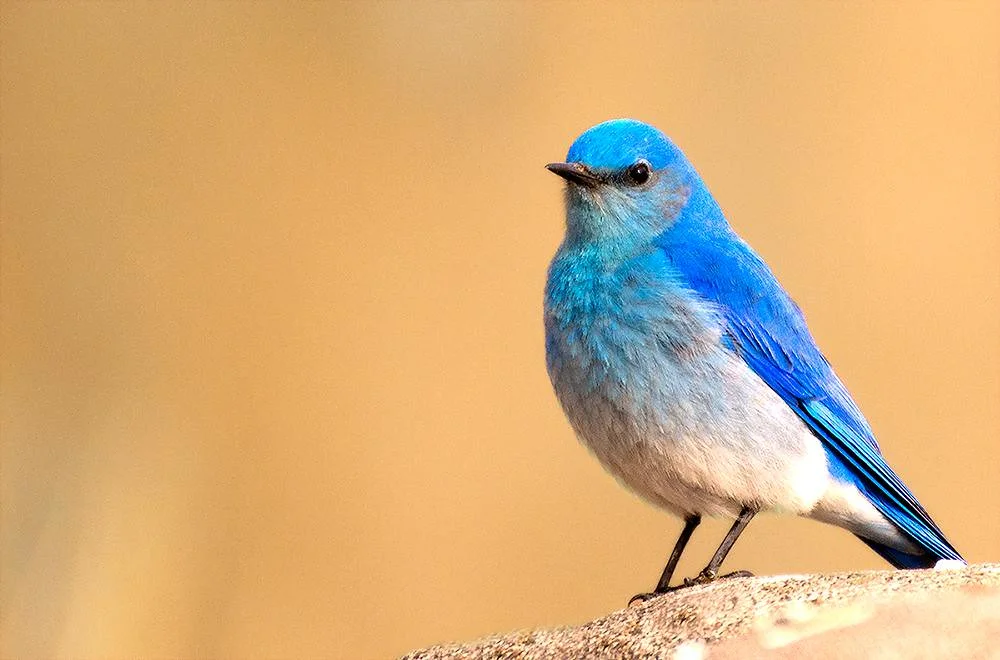
Mountain Bluebirds are gorgeous California bluebirds. Although females are gray overall instead of blue, the males have a dazzling light blue coloration. Like all bluebirds, there is no difference in appearance between breeding and nonbreeding plumage.
Mountain Bluebirds spend their winters in the Central Valley and southern California. They are uncommon birds in the California Bay Area, with sightings around San Francisco being notable. In the summer, birds ascend in the Sierra Nevada Mountains and other areas of similar altitude.
Meadows bordered by dead trees with cavities are ideal breeding locations for this species. In winter, they like open areas where they have a chance to capture lots of insects. They can readily be observed on fences, wires, signs, and other obvious locations.
Western Bluebird
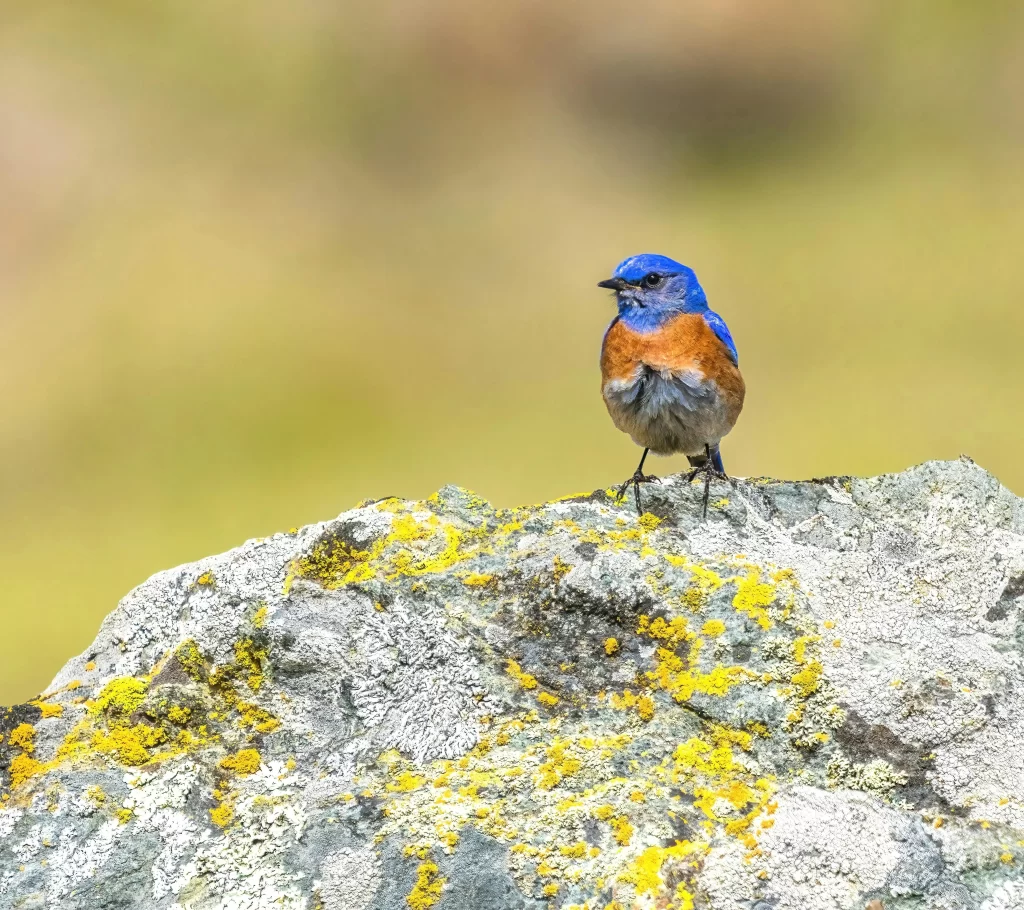
Western Bluebirds fit the traditional image of a bluebird better than their Mountain counterparts, as both males and females have royal blue on their backs. Additionally, Western Bluebirds have varying amounts of orange on their chests and white undersides.
These California bluebirds can be found throughout most of the state in both summer and winter. They do not tend to breed at altitudes as high as Mountain Bluebirds, but they still may be found at considerable elevations.
Like all bluebirds, they are cavity nesters, so they require habitat with dead trees to facilitate nesting. Therefore, parks, windbreaks, farmsteads, and other semi-open areas with tree cover are ideal.
Yellow-rumped Warbler

Yellow-rumped Warblers are the most common warblers in California, making them a familiar sight to many. Males have blue-gray hoods with color that extends down their backs. These blue birds of California also have captivating yellow throats and black, blue, and white undersides. Females are bluish-gray overall with yellow throats and a yellow crown stripe.
These California blue birds can be found almost anywhere west of the Sierra Nevadas during winter. They make use of any forested habitat, but they may also be found in rather open areas with minimal trees. A walk through a park, cemetery, woodlot, or any other area with a few trees will likely reward one with a view of this species.
Yellow-rumped Warblers breed in the Sierra Nevada Mountains in good numbers, but they will reproduce anywhere with dense concentrations of trees. Coniferous trees—in particular—are used by this California blue bird for breeding.
Blue Grosbeak

Blue Grosbeaks are an interesting blue bird in California. On one end of the spectrum are males with their rich blue bodies and rusty shoulders. However, females are not at all blue, as they are well-camouflaged songbirds with olive-colored bodies.
These dark blue birds are completely absent from California in the winter, as they travel to Mexico and Central America during this time. However, come spring, these California blue birds push north and settle in the state as far north as Redding.
Blue Grosbeaks are shy birds for the most part, but a birder may be able to catch a glimpse of a male as he sings his beautiful song from an exposed perch. This species breeds in low, semi-open areas, so California’s Central Valley and southern California are ideal.
Lazuli Bunting

In typical bunting fashion, male Lazuli Buntings are extravagant, while females are drab and unassuming. Males are a sight to see with their sky-blue heads, orange chests, white stomachs, and blue tails.
Much like Blue Grosbeaks, Lazuli Buntings leave California entirely in the winter. During this time, they reside in western Mexico, however, they return in the spring to prepare for the summer breeding season. These small blue birds can be found throughout the state during this time.
Lazuli Buntings seek scrubby habitats such as areas with young trees and shrubs, as these are optimal conditions to raise their young. They like to breed on hillsides and adjacent to waterways, but they aren’t picky – any semi-open area with adequate vegetation will do.

